Contents
of the Summer 2012 Northants News
|
A
Day in Denver
Trevor
Wray
|
At
the end of our recent US trip the FL and I had the day to spare in Denver before
our long night journey home. Many Brits would settle for a day at the shopping
malls and outlets but our suitcases were already bulging. A gentle day at the
Botanical Garden was indicated; pack our suitcases first, over to the gardens
for the Conservatory before it got too hot, a stroll to every corner and a late
lunch in the air-conditioned restaurant. Afternoon temperatures were indicated
in the low 90ºs F so we could chill out.
|
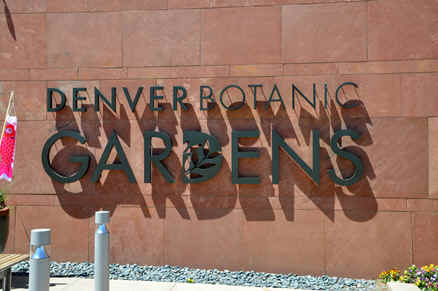
|
It
was not to be - the Garden was only open for the morning, apparently there
was a weekend plant sale on and the place was closed to aid preparation.
Revised plan was a dawn packing session and we were at the doors of the
garden as they opened at 9am. The Conservatory was as I remembered it from
a previous visit, a jungle of well grown tropical plants. Some orchids
were especially outstanding but it was the display of poisonous tree frogs
Phyllobates
in jewelled yellow and black jackets that took my eye. |
|
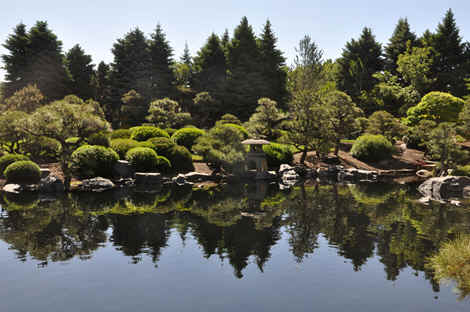
|
My
previous visit to the Garden had been in early April when flowers in the
open had been sparse following Denver's harsh winter and late snowfall.
Now in mid-May there was a riot of colour. The herbaceous borders were in
full bloom with many attractive plants and there were many irises and
peonies which rate among my favourite plants. The Japanese Garden was a
restful delight with shade, dwarf trees and reflections across the
traditional lake. |
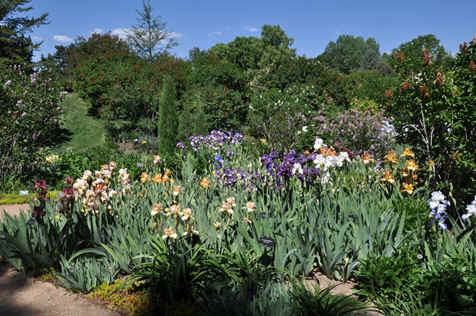
|
|
Tranquil
view in the Japanese Garden at Denver BG |
Colourful
bearded irises. |
As
a botanical garden I would rate Denver as very much a gardeners' garden. The
hard landscaping is very artistic and complemented by the planting which only
vaguely follows botanical classification. However most of the plants are clearly
labelled which is a help.
Naturally
I wanted to see the succulents and there is a well grown collection under glass.
Strangely this must be one of the coldest places in the garden; the air-con was
working full blast. Perhaps this was a throwback to years ago when this building
was the alpine house! Anyway the plants looked well on this regime. Just outside
is a large alpine garden and it was full of flowers but very hot.
|
The
outdoor plantings of native succulents were quite new on my previous visit
and have mellowed well. There were many cacti in full flower and a couple
of 'triglies' were doing their thing. I have to explain that this is my
name for plants of the Echinocereus
triglogidiatus
group and I include E.
coccineus. They
are difficult to name with certainty. Most Americans would simply call
them 'claret cups'. The two seen in my image are the giant form typically
seen at White Sands, NM and a regular version. All spectacular when seen
in habitat as well. You will see that in the garden cacti associate well
with California poppies. However, in the wild the species seen with
southern Californian and Arizona cacti is the similar Mexican poppy. There
were many Opuntia species, both prickly pears and chollas, in bloom. These
plants are often planted in urban gardens for their drought and cold
resisting abilities. I was not surprised to see the choice small growing Escobaria
leei
planted in a niche on the rock garden. this species would be overgrown by
poppies and more vigorous cacti in the succulent beds. Finally there was a
neat Echinocereus
viridiflorus
in a trough of native plants. We were to see that in the afternoon. |
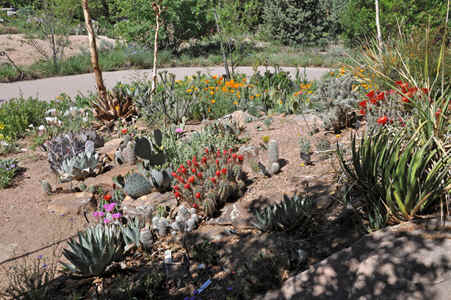
|
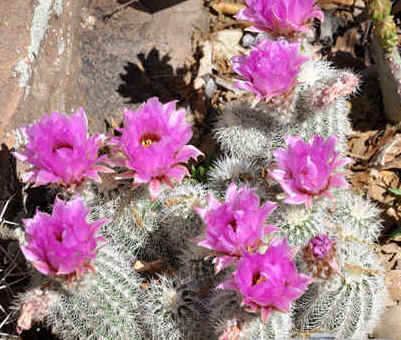 |
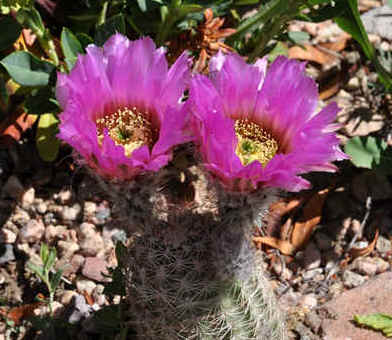 |
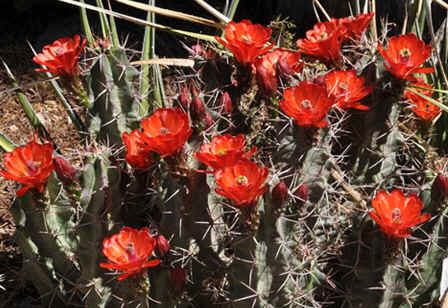 |
|
Flowering
plants of Echinocereus reichenbachii ssp. baileyi outside at
Denver BG |
Echinocereus
triglochidiatus |
|
In
the afternoon our US sat-nav led us nearly unerringly to the Will Hayden,
Green Mountain Park on the outskirts of Denver. We had enjoyed the
civilised environs and cultivated plants at the Botanical Garden, but
there was still time for a last 'wilderness' experience. Green Mountain
Park is a series of rolling grassy hills and although I use the adjective
'wilderness' because the vegetation type is natural and apparently
mountain lions live here, the area is widely used for leisure. Cyclists on
mountain bikes and joggers were often encountered. We failed to see the
mountain lions. |
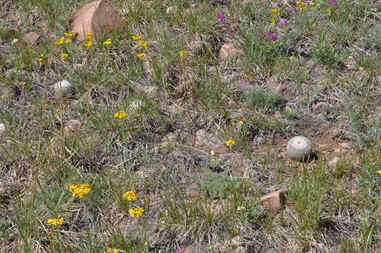
|
|
Echinocereus
viridiflorus and Pediocactus simpsonii in the turf. |
I
have been here twice before. Once in mid-April when it was freezing and snow
still lay on north slopes and once in mid-May when thunder rolled, it was trying
very hard to rain, and it was nearly freezing. None of these conditions would be
conducive to seeing the three common species of local cacti in flower you might
think.
Now
it was mid-May again and the temperature had reached that predicted low 90sF.
Well, back in mid-April Pediocactus
simpsonii had
been in flower despite the cold. It seems to need only the sun to open its
blooms.
Echinocereus
viridiflorus
(remember I had seen that in the morning) was in bud in April 2006, but the
flowers were closed in May 2006, due to clouds or cold. Now in the heat it was
in full bloom. We could see flowers everywhere in the grass, even where the
plants were not too evident.
This
is one of those species, like small Pediocactus, that retract into the soil in
the heat of summer and the cold of winter and pop up to flower and set seed in
spring. The species is reported to have a strong scent, perhaps to make up for
its small, green-yellow flowers. Certainly my cultivated plants have a rich
citrus scent. Would the FL oblige? It's my arthritis you understand... and there
could be snakes and prickly pears and other hidden cacti and someone has to
drive the car to the airport. Sue duly reported no scent and I took the picture.
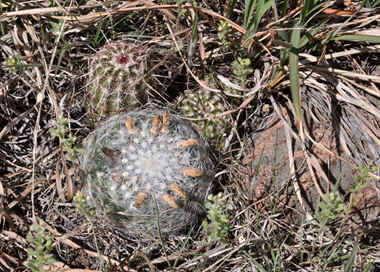 |
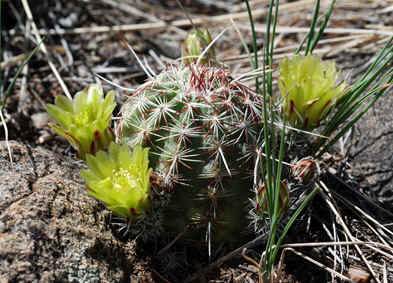 |
I
also captured Echinocereus
viridiflorus
and Pediocactus
simpsonii
together. When I featured a similar image in the Spring issue of NN in
2005 I explained they were cuddling to keep warm, but at 90ºF I am not
sure what these are doing.
The
prickly pear here is the common Opuntia
polyacantha
and was covered in buds. I captured just one yellow bloom open. This
version had pretty lethal spines and a good encouragement to mountain
bikers to keep to the trail. |
|
Left:
Echinocereus and Pediocactus on Green Mountain Right: E.
viridiflorus in flower |
So
a great end to a great holiday. Sue will remember the grizzly bears of
Yellowstone and I can dream about an afternoon on Green Mountain. Oh, by
the way, there were some really beautiful wild flowers open beside the cacti.
Trev
P.S.
I was led to Green Mountain by Don Campbell - see tribute below.
Don
Campbell has written on many occasions for NN about habitats in the US. There
have also been the odd pictures of his cultivated plants. Reading the newsletter
of the Colorado Cactus and Succulent Society I see he has been awarded the Mary
Ann Heacock Award from the local society. Don wrote…
During
the past 25 + years I’ve thoroughly enjoyed CCSS and the many opportunities
membership has provided.
And
while I’ve gained valuable knowledge about succulent plants, their habitats
and how to care for them, I most value the camaraderie and friendship associated
with membership of CCSS.
Over
the years there’s no doubt but that I’ve been the primary beneficiary of
this relationship.
Thanks
to all of you for helping me develop into the unrepentant cactophile that I am.
Cactophilitically
Don
Campbell
Well
yes Don, well written. And I am fully aware that I picked your name and email
address up as a contact in the area and thanks to your generosity have on
several occasions been led to the habitats of both common and rare cacti in your
homeland.
And your ‘yard’ (garden) and the native cactus gardens in Grand
Junction are very well worth the visit. (many of my UK cactus friends and some
Czech contacts have also benefitted. Your pot cultivated plants
are a credit to you and we have featured a few images over the years here
in NN.
But
that is your accolade. I was wondering what I might be known for at our local
cactus branch.
I
have paraphrased your text.
During
the past 40 + years I’ve thoroughly enjoyed membership of the BCSS and the
many opportunities provided.
And
while I’ve gained valuable knowledge about succulent plants, their habitats
and how to care for them, I most value the camaraderie and friendship associated
with membership of BCSS.
Over
the years there’s no doubt but that I’ve been the primary beneficiary of
this relationship.
Thanks
to all of you for helping me develop into the unrepentant cactophile that I am.
Cactophilitically
Trev
And
I see that Don is signing himself ‘cactophilitically’ Don. Did he learn that
from me, or me from him? Or from Gordon Rowley?
Trev
|
Some
thoughts on seeds
Doug
Rowland
|
Doug
brings us some of his insights into his long experience with seed raising and
seed dealing.
Growing
from seeds
This is not the
easiest form of propagation. The rooting of detached stems, cuttings, spare
rosettes and offsets in spring is much more rewarding. However if you have lots
of patience and are used to disappointments then seed raising is for you.
Make up a soil mix of
half general potting compost and grit, and place in 2” or 5cm pots. Lightly
tamp down and sprinkle seeds on the surface and insert label with full name of
species. Invest in a tin of Cheshunt Compound and stand pots in the mix until
soaked. If this fungicide is not used, seeds from wet berries will promptly rot
off and grow some beautiful mould for you.
Place
pots on heated base of propagator. Cover with lid and make sure seeds are kept
moist at 70ºF.
Germination should take place within 4 to 14 days. And, if the seeds are not
viable, never! Remove lid of propagator and spray from above about every two
days, using your Compound mix. Seeds will now grow very slowly and need daily
care. Some may disappear and others will grow on well, but there is always a
chance the mice or livestock will be present, and an occasional spray of
insecticide is favourable. Conophytum and all winter growing seeds are best sown
in autumn and other seeds in spring. I found that the most rewarding seeds to
grow were Mesembs, Aloe, and Agave.
Doug
Rowland
June 2012
Seeds
- Importing
The European Economic
Community consists of 27 member States, and for the purpose of trading, is
regarded as a single country by the rest of the world. No Customs Labels are
required on postal items when goods pass over international borders within the
Community. This means that plants and seeds may be sent easily and quickly into
Member States.
To import seeds in to
the Community, they must be clean, dry, and free of all debris and livestock or
insect presence. However, Appendix A CITES seeds will require paperwork. It is
not very practical or possible to produce desert plant seeds in quantity in the
United Kingdom. But with it being so easy to import seeds into the EEC, home
production is hardly worthwhile.
Seeds arrive here
from many different sources. Some seeds are produced in central Europe in
cultivation under glass, where they have hot, dry summers, which brings out the
flowers and camel haired pollinating brushes. In the United States, many cactus
plants are grown in boxes in cultivation, and again these are producing seeds in
quantity as well as in outdoor beds. Under glass, many Mesembs, including
Lithops and Conophytum, whilst Agave, Dasylirion and the like will produce seeds
outside along with Yucca. Mesemb, Aloe, and Ferocactus seeds come in from RSA
occasionally with a few Cycas species which are very heavy and rather expensive
to airlift. Australia and North Island of New Zealand often supply Agave and
assorted seeds of Cactaceae as well as Fern spores which grow on well if sown
when freshly gathered. From India attractive and strange tree seeds can be
obtained. South American Cactaceae seeds come in from Chile, Argentina and Peru.
But in general, many seeds offered in lists are produced in cultivation.
Some species of
desert plants are almost impossible to grow in cultivation due to requiring
specialist soil, extra heat, or, like Ariocarpus, take ten years to make a small
plant. The Pediocactus and Sclerocactus groups are all nigh impossible in
cultivation, and to possess a plant it may well have to be grafted on to hardy
stock. Being in the seed business is rather like entering a hopeless struggle.
Everyone wants the seeds that are difficult or impossible to obtain or grow, and
no one seems to want seeds of general desert plants which are plentiful, quicker
and easier to acquire.
Upon arrival, all
seeds have to be examined and hand sorted, occasionally washed out of capsules
such as Lithops or Dinteranthus. Occasionally seeds of Crassulaceae arrive in
very crushed capsules and are almost impossible to clean, and of short
viability. Sometimes dealers send a half lot of immature seeds, which have to be
hand sorted also. But the biggest problem with seeds is their viability. Some,
like Mesembs have 10 years, most Cactaceae two years, and Asclepiadaceae, just a
few weeks. Lots of dealers advertise freshly collected seeds, and I am afraid
that the term freshly is used rather too loosely.
EXPORTING.
This
is rather more complicated and difficult than importing. All the main English
speaking countries have strict rules except Canada, which is OK so long as you
do not include any seeds of pines. So, let us start with the USA. Until a few
years ago it was the ‘Land of the Free’, but nowadays seeds require to be
accompanied by a Phytosanitary Certificate or a Permit with conditions, to be
obtained by the buyer. Seeds of Lophophora
williamsii and its
congeners are completely banned as the plant, though native to Texas is regarded
as a narcotic. Australia has a problem with invasive and noxious species. They
have a list of species that are allowed into the country, but every pack of
seeds is detained and examined and all packets must bear the full botanical name
of the seeds inside. Lophophora williamsii is also banned here and in New
Zealand.
Unfortunately, new colour forms of some Lithops species do not appear on
the list and are confiscated and destroyed. New Zealand has a similar system,
but here the packets are detained and opened. Lots of small native alpines are
threatened and smothered by invasive species brought in, such as heather, by
Scottish settlers many years ago, and now rampant and thriving.
Many West Indian
countries require Phytosanitary Certificates which usually cost £100 plus each,
and each little packet is opened and seeds, sometimes resembling dust are
examined. Often seed packets are not resealed properly, and occasionally seeds
escape. Israel requires in addition a chemical treatment, now impossible to do
yourself any more under the health and Safety Regulations. It is unfortunate
that Customs authorities treat five seeds in a packet as they do a ship load of
grain. Occasionally these people make their own rules like the Indian Customs
man who wanted to do a germination check. But fortunately there are ways and
means and occasionally, a little common sense.
But usually the
better and more amenable countries are Canada, India, Russia and its Republics,
Thailand, and South Africa which has problems with invasive species also. With
these kind of difficulties, many suppliers are reluctant to send seeds to
countries outside the EEC.
PAYMENT
Bank charges on
foreign currency cheques are usually around £15 plus each, and occasionally
cheques and payment drafts are charged for at both ends. Commission is also
charged on the purchase of currency notes, which can easily disappear in the
post to South Africa and South America. Often a claim for loss will not be
settled for at least six months, as foreign post offices do not usually reply to
Royal Mail enquiries. So, an exchange or swap is sometimes an easier way out of
a difficult situation. I also found that Air flight charges on large Araucaria
seeds from Australia and Cycad seeds from Africa were prohibitive. There
are other problems to face such as the increasing cost each year of 2 ¼“
glassine seed packets. These are usually only available through a local
wholesaler, who adds on his share of the cost. The printing of seed lists in
quantity with coloured covers was becoming very expensive and with envelopes,
stickers and stamps ran to around a cost of 75p inland and twice that overseas a
few years ago. There are also a lot
of list-collectors about, as only half the lists sent out are purchased from.
Often orders would come in from lists up to 10 years old. Later on we had our
list copied by a computer cum printing machine where sheets of A4 went in at one
end, and A5 booklet seed lists came out the other end at fractional prices. We
also found that it was too expensive to airmail plant labels and so-called
‘permanent’ pens to overseas countries, items not being very good value for
money.
Summarizing, selling
seeds outside the EEC is fraught with difficulties of one kind or another.
Nowadays, with a very shrunken hobby, members are not growing from seeds as they
used to, and consequently a much reduced number of species are now available.
Doug










